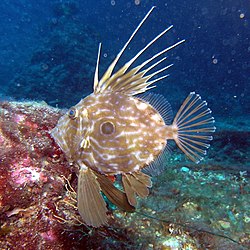John Dory
Species of fish From Wikipedia, the free encyclopedia
John Dory, St Pierre, or Peter's fish, refers to fish of the genus Zeus, especially Zeus faber, of widespread distribution. It is an edible demersal coastal marine fish with a laterally compressed olive-yellow body which has a large dark spot, and long spines on the dorsal fin. Its large eyes at the front of the head provide it with binocular vision and depth perception, which are important for predators. The John Dory's eye spot on the side of its body also confuses prey, which are scooped up in its large mouth.[3][4]
This article needs additional citations for verification. (June 2024) |
| John Dory Temporal range: | |
|---|---|
 | |
| Zeus faber | |
| Scientific classification | |
| Domain: | Eukaryota |
| Kingdom: | Animalia |
| Phylum: | Chordata |
| Class: | Actinopterygii |
| Order: | Zeiformes |
| Family: | Zeidae |
| Genus: | Zeus |
| Species: | Z. faber |
| Binomial name | |
| Zeus faber | |
| Synonyms[2] | |
| |
In New Zealand, Māori know it as kuparu, and on the East Coast of the North Island, they gave some to Captain James Cook on his first voyage to New Zealand in 1769. Several casks of them were pickled.[3]
Etymology

The name dory is attested from 1440, derived from the French dorée 'gilded', a French name for the fish. The addition of "John" appears in 1609, and probably comes from a 17th-century song about a sea captain, John Dory. Etymologies claiming it comes from the French jaune dorée (meaning "golden yellow") which sounds like 'John Dory' in English, or the Italian gianitore 'janitor' are now rejected.[5]
A legend says that the dark spot on the fish's flank is St. Peter's thumbprint.[6] In the north coast of Spain, it is known commonly as San Martiño, or San Martín. The Māori language name for the fish, kuparu, appears to be unique to New Zealand, as there are no cognates found in other Polynesian languages.[7]
Morphology
The John Dory grows to a maximum size of 65 cm (26 in) and 5 kg (11 lb) in weight. It has 10 long spines on its dorsal fin and 4 spines on its anal fin. It has microscopic, sharp scales that run around the body. The fish is an olive green color with a silver white belly and has a dark spot on its side. Its eyes are near the top of its head. It has a flat, round body shape and is a poor swimmer.[citation needed]
Prey and predators

The John Dory catches prey by stalking it, then extending its jaw forward in a tube-like structure to suck the fish in with some water. The water then flows out through the gills; the pre-maxillary bone, the only tooth-bearing bone in this fish, is used to grind the food.
The John Dory has a high laterally compressed body – its body is so thin it can hardly be seen from the front. The large eyes at the front of the head provide it with the binocular vision and depth perception it needs to catch prey. This eye spot also confuses prey, which can then be sucked into its mouth.[8]
It primarily eats smaller fish, especially schooling fish such as sardines. Occasionally it eats squid and cuttlefish.[citation needed]

Its main predators are sharks such as the dusky shark, and large bony fish.[citation needed]
Habitat
John Dory are benthopelagic coastal fish, found on the coasts of Africa, South East Asia, New Zealand, Australia, the coasts of Japan, and on the coasts of Europe. They live near the seabed, living in depths from 5 to 360 metres (20 to 1,180 ft). They are normally solitary. John Dory are more commonly found in the waters of the North Island of New Zealand than the colder waters surrounding the South Island.[7]
Reproduction and lifespan
This section includes a list of general references, but it lacks sufficient corresponding inline citations. (June 2024) |
When John Dories are three or four years of age, they are ready to reproduce. This happens around the end of winter. They are substrate scatterers, which means that they release sperm and eggs into the water to fertilize. Typical lifespan is about 12 years in the wild.[citation needed]
As food

Cookery writer Eliza Acton in her 1845 book Modern Cookery for Private Families observed that John Dory "though of uninviting appearance, is considered by some persons as the most delicious fish that appears at table". She recommends simply baking it "very gently", avoiding it drying out in the oven.[9]
John Dory is a popular choice among professional chefs due to the versatility of the fish, though access to home cooks is limited; the bycatch fish is not typically sold at supermarkets.[10]
References
Sources
External links
Wikiwand - on
Seamless Wikipedia browsing. On steroids.



